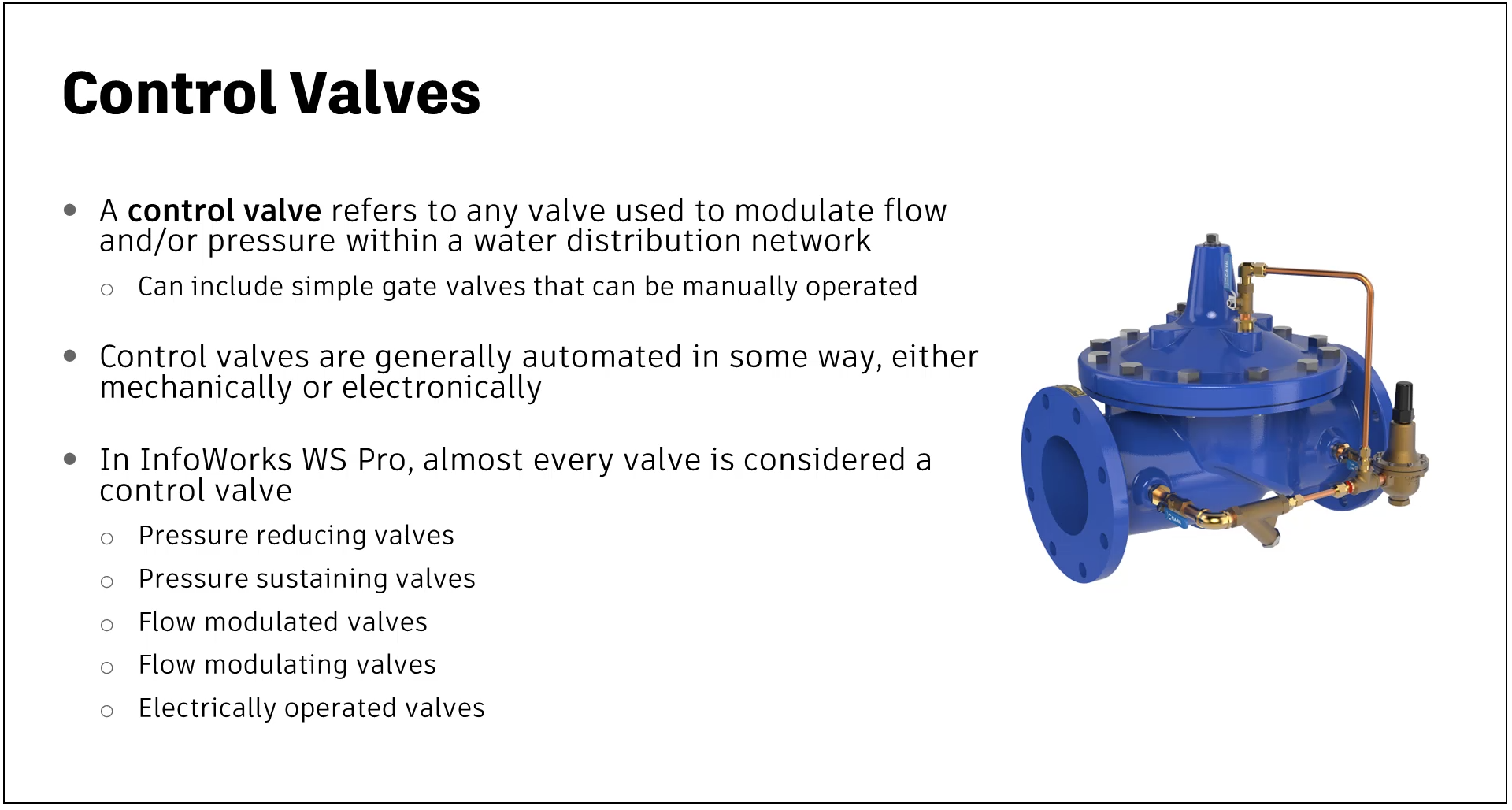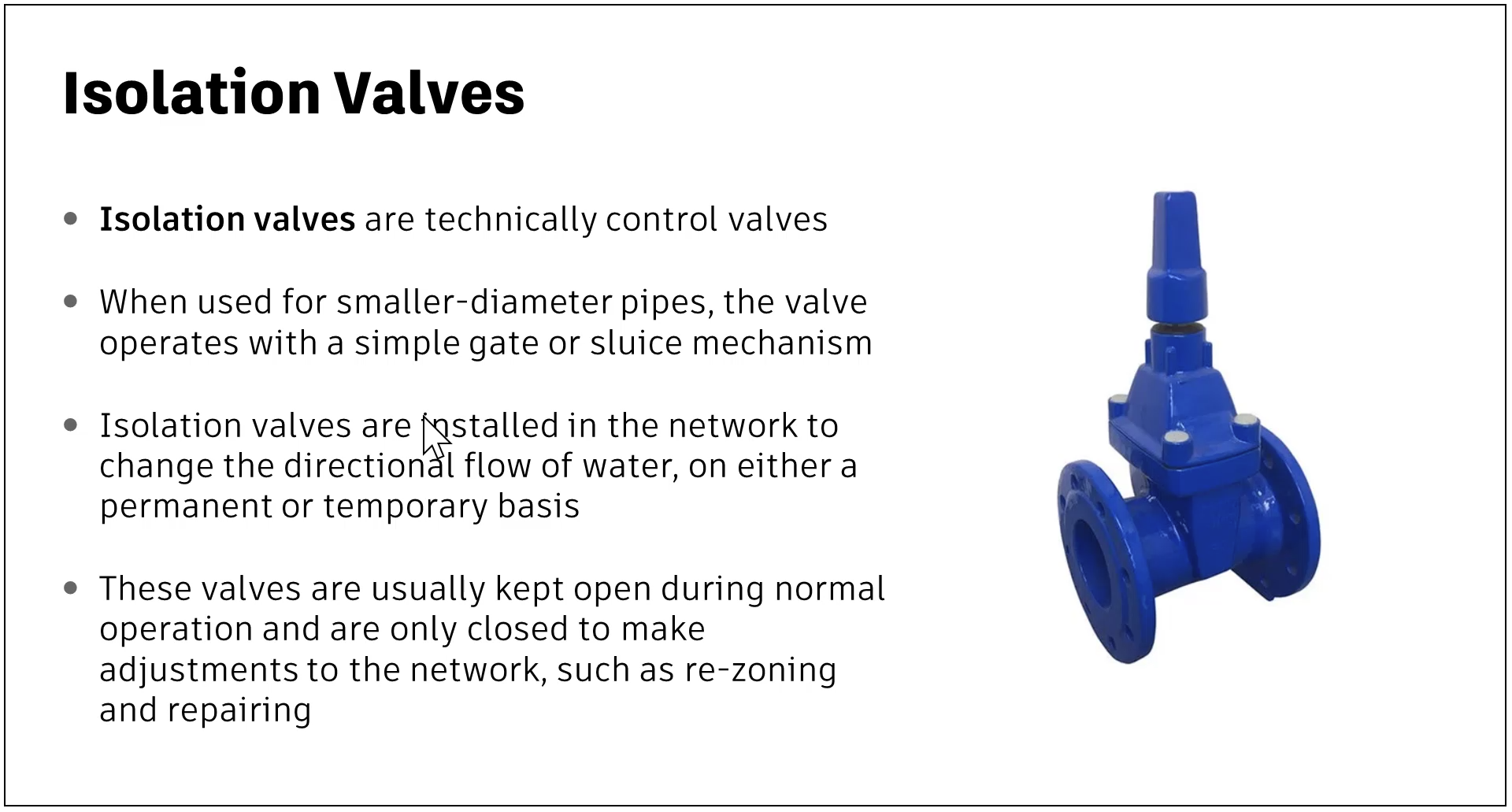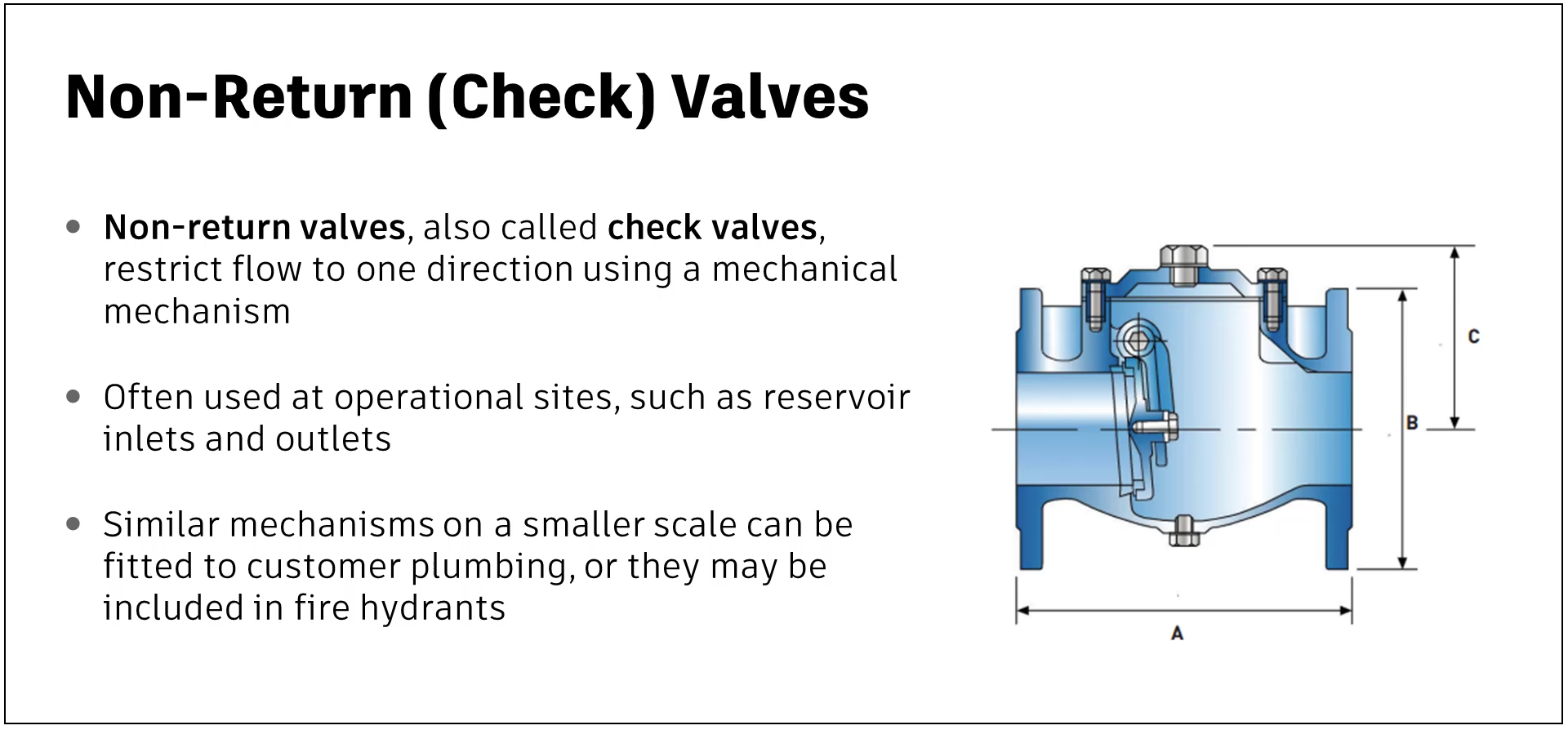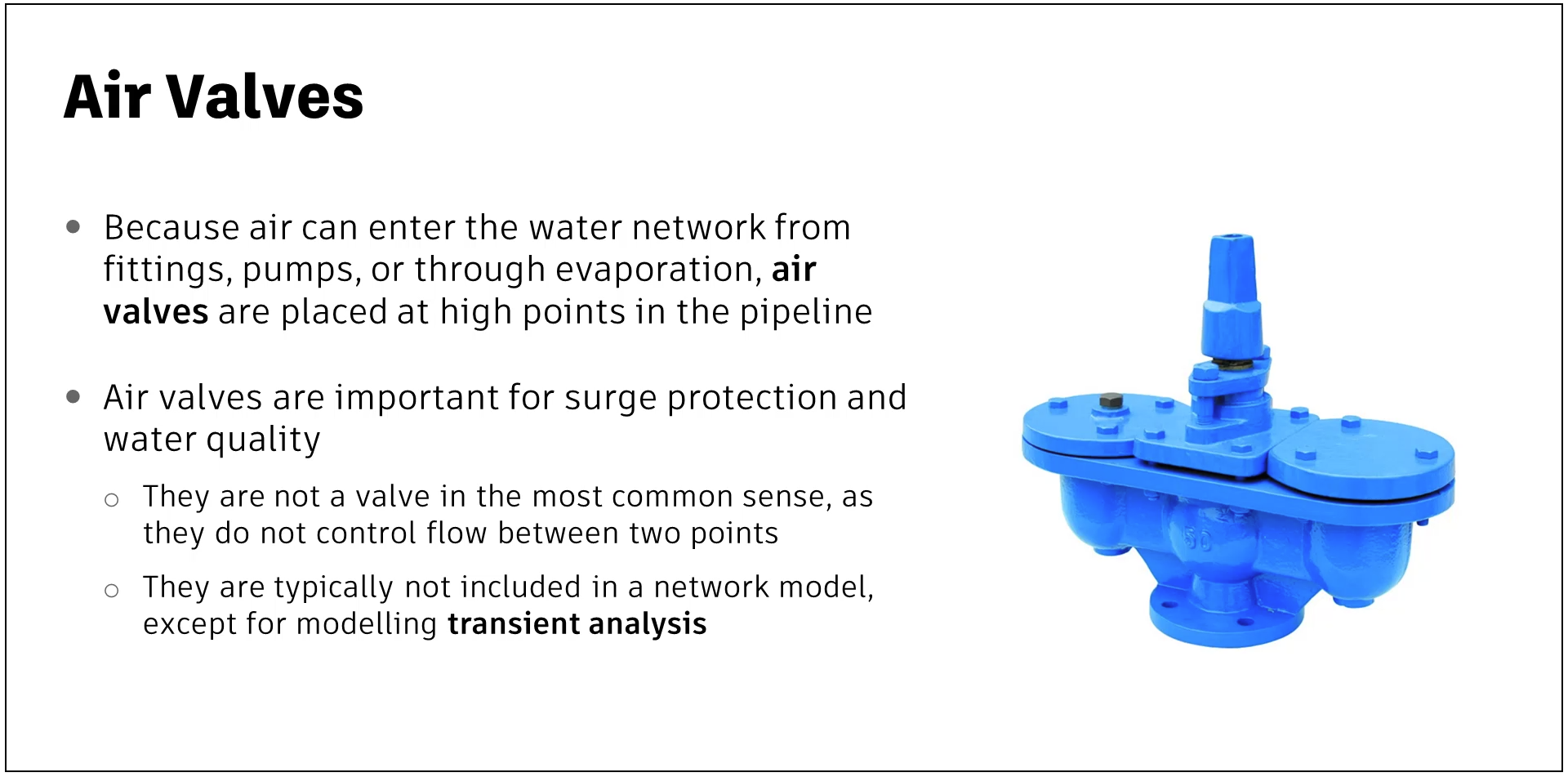& Construction

Integrated BIM tools, including Revit, AutoCAD, and Civil 3D
& Manufacturing

Professional CAD/CAM tools built on Inventor and AutoCAD

Integrated BIM tools, including Revit, AutoCAD, and Civil 3D

Professional CAD/CAM tools built on Inventor and AutoCAD
Transcript
00:04
A control valve is an essential component of a water network.
00:08
A control valve refers to any valve used to modulate
00:11
flow and or pressure with any water distribution network.
00:16
This can include simple gate valves that can be manually operated
00:20
control valves, however, are generally automated in some way,
00:24
either mechanically or electronically
00:27
in info works.
00:28
WS pro almost every valve is considered
00:31
a control valve including pressure reducing valves,
00:35
pressure sustaining valves,
00:37
flow, modulated valves,
00:39
flow modulating valves
00:41
and electrically operated valves. Eovs
00:45
the mechanism of the valve is important to understand as this
00:48
can affect pressure loss as the valve opens or closes.
00:53
Many types of advanced control valves like PRVS are globe valves
00:57
which are commonly used to regulate the flow in a pipeline
01:02
isolation. Valves are technically control valves
01:05
when used for smaller diameter pipes. The valve operates with a simple gate or slice
01:10
mechanism.
01:12
Isolation valves are installed in the network to change the directional
01:16
flow of water either on a permanent or temporary basis.
01:21
These valves are usually kept open during normal operation and are only
01:25
closed to make adjustments to the network such as rezoning or repairing
01:31
non
01:31
return valves also called check valves restrict
01:34
flow to one direction using a mechanism.
01:38
Non
01:38
return valves are often used in operational
01:40
sites such as reservoir inlets or outlets.
01:45
Similar mechanisms on a smaller scale can be fitted to customer
01:48
supplies or plumbing or they may be included in fire hydrants
01:53
because air can enter the water network from fittings,
01:56
pumps or through evaporation.
01:58
Air valves are placed at high points in the pipeline.
02:02
Air valves are important for surge protection and water quality but they are not a
02:06
valve in the most common sense as they do not control flow between two points.
02:11
Therefore,
02:12
they are typically not included in a
02:14
network model except for modeling transient analysis.
02:18
Having a basic understanding of how valves play a part in
02:21
an efficient water supply network is essential when modeling a network.
Video transcript
00:04
A control valve is an essential component of a water network.
00:08
A control valve refers to any valve used to modulate
00:11
flow and or pressure with any water distribution network.
00:16
This can include simple gate valves that can be manually operated
00:20
control valves, however, are generally automated in some way,
00:24
either mechanically or electronically
00:27
in info works.
00:28
WS pro almost every valve is considered
00:31
a control valve including pressure reducing valves,
00:35
pressure sustaining valves,
00:37
flow, modulated valves,
00:39
flow modulating valves
00:41
and electrically operated valves. Eovs
00:45
the mechanism of the valve is important to understand as this
00:48
can affect pressure loss as the valve opens or closes.
00:53
Many types of advanced control valves like PRVS are globe valves
00:57
which are commonly used to regulate the flow in a pipeline
01:02
isolation. Valves are technically control valves
01:05
when used for smaller diameter pipes. The valve operates with a simple gate or slice
01:10
mechanism.
01:12
Isolation valves are installed in the network to change the directional
01:16
flow of water either on a permanent or temporary basis.
01:21
These valves are usually kept open during normal operation and are only
01:25
closed to make adjustments to the network such as rezoning or repairing
01:31
non
01:31
return valves also called check valves restrict
01:34
flow to one direction using a mechanism.
01:38
Non
01:38
return valves are often used in operational
01:40
sites such as reservoir inlets or outlets.
01:45
Similar mechanisms on a smaller scale can be fitted to customer
01:48
supplies or plumbing or they may be included in fire hydrants
01:53
because air can enter the water network from fittings,
01:56
pumps or through evaporation.
01:58
Air valves are placed at high points in the pipeline.
02:02
Air valves are important for surge protection and water quality but they are not a
02:06
valve in the most common sense as they do not control flow between two points.
02:11
Therefore,
02:12
they are typically not included in a
02:14
network model except for modeling transient analysis.
02:18
Having a basic understanding of how valves play a part in
02:21
an efficient water supply network is essential when modeling a network.
A control valve is an essential component of a water network.

The mechanism of a valve can affect pressure loss as the valve opens or closes. Many types of advanced control valves (like PRVs) are globe valves, which are commonly used to regulate the flow in a pipeline.



How to buy
Privacy | Do not sell or share my personal information | Cookie preferences | Report noncompliance | Terms of use | Legal | © 2025 Autodesk Inc. All rights reserved
Sign in to start learning
Sign in for unlimited free access to all learning content.Save your progress
Take assessments
Receive personalized recommendations
May we collect and use your data?
Learn more about the Third Party Services we use and our Privacy Statement.May we collect and use your data to tailor your experience?
Explore the benefits of a customized experience by managing your privacy settings for this site or visit our Privacy Statement to learn more about your options.